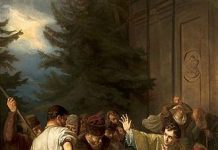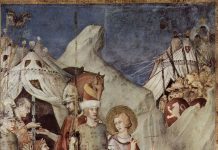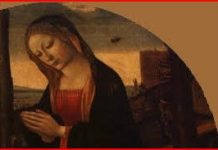On July 27th the Church celebrates the feast of Blessed Maria Maddalena Martinengo. The Northern Italian Capuchin nun teaches us how to love Christ in humility and total simplicity.
Mary was born from a noble family who lived in Brescia on October 4, 1687, at the Martinengo palace in Brescia. Sadly, the ordeal cost the life of her mother, the noble Margherita Secchi d’Aragona. Fearing that the baby might die, Mary was immediately baptized, and fittingly given her Mother’s name.
Margherita was a very smart girl, and at the age of six, started frequenting the Ursuline school. Isabella Marazzi, her teacher, took great care in helping the little Margherita to progress in prayer and study. Her life story tells us that the Breviary was the reading she liked most, and, as well, the rosary was always in her hand. This was the common memory of her. Years later, the same Margherita would say in her autobiography: I found all my contentment in reading. The latter opened Margherita to a strong formation in both Italian and Latin literature. She was greatly aided by her father’s outstanding library.
She recounts an event that took place in her early childhood whilst being on a journey within a carriage which was drawn by six horses. She says that she fell out. Margherita was utterly convinced that she would have been run over and killed on the spot had not Providence intervened by a touch of an invisible hand which took her out from all this danger. She entered the monastery boarding school of the Augustinian nuns at Santa Maria degli Angeli, on October 11, 1698, at 11 years old. In this boarding school two of the nuns were maternal aunts, and it was there that she continued her education.
It is interesting that her first Holy Communion was somewhat dramatic to her. As a matter of fact the Host just fell on the floor due to the great emotion he felt. Margherita had to pick it up with her tongue. However she could not do it due to the tremendous cold her limbs had. She interpreted this fact as if the Lord did not see her worthy to receive it. Her spiritual reading led Margherita to become more and more interested in mortification and meditation, which aroused much jealousy and control in the heart of her aunts that they constrained her father, in August 1699, to transfer her to the Spirito Santo boarding school of the Benedictines.
Before going there, Margherita had a very enjoyable family vacation for a couple of months in the beautiful mountains around Lago d’Iseo. In this magic place she started having a serious inkling to enclosed contemplative life. In her later autobiography she speaks of how she was enamoured with the scene of those uninhabited alpine regions , and the grottoes that were so beautiful that they seemed to call me to live there. Without a doubt I would have run off to them, had the number of wolves not frightened me. Let us not forget that Margherita had previously tried a similar escape at Santa Maria degli Angeli. Accompanied by her two companions the little girl tried to flee to a hermitage to suffer there as much as she wanted. Nevertheless, the secret door of the monastery was locked, thus this prevented her from going out.
It needs to be said that in the Santo Spirito monastery there resided other two maternal aunts. Although they were not as jealous as the other two at Santa Maria degli Angeli Augustinian nuns, they seemed to show enough care only about her health and her future as a noble-woman in high society. Margherita later wrote in her autobiography: I was so bored that I would not have become a religious there for all the gold in the world. In the meantime, her charismatic vocation started gaining momentum. In her relationship with God, her inner prayer filled her with fire. Because her fragile adolescent psychology could not go hand-in-hand with the ways of the divine, in the end Margherita simply fell ill. The sisters, unaware of what was happening in me, made me even worse with repeated medicines. As it turned out it was solely God who wounded her and could, eventually, provide her with a cure.
At the tender age of thirteen, Margherita wrote that when I vowed my virginity to God. Following this great spiritual moment Margherita had to withstand harsh attacks of all sorts of temptations. The experience was surely terrible and overwhelming. When she reached sixteen years of age many wanted to marry her. This led to her father arranging a marriage to the son of a Venetian senator. To this end, her brothers, Nestore and Gianfrancesco, tried to put her on this wavelength by providing her with books replete with love stories. The young woman Margherita was enticed by them so much that she spent night and day reading them. Later on she reproved herself for such a thing. She said that they were for her books from hell.
As a young woman Margherita loved so much to dress up in a refined way. Having said that, one day, while expressing her heartbrokenness in front of Tabernacle she somehow felt that one day she would be clothed by the rough natural wool of the Capuchin Poor Clares. Margherita was somehow convinced that this would be the case by a mysterious inner light with which she was filled. And this light came directly to her by the Mother of God thanks to a vision she had and later she was able to recount. Nevertheless, Margherita later confided: I knew nothing about the Capuchin Nuns. She was now eighteen years of age.
After completing the education in Santo Spirito monastery, the young Margherita went back home. It was the year 1704. The problem was now how to tell her father about the decision of consecrating herself to God. Even if inside her she wanted to sideline the idea she could not help herself from insisting that all she wanted was to become a Capuchin Nun. Her teachers, confessor, father, brothers and even the servants were totally opposed to her idea.
However, no one could change her mind, so that exactly four days later, on Christmas day, Margherita went to the Capuchin Poor Clare monastery of Santa Maria della Neve and there she presented herself with the following words: I want to be holy. According to the custom of those years, the sisters sent her to spend a period of probation just before taking the habit. The probation occurred in the city, in the Maggi College administered by the Ursulines.
After Lent had passed, Count Leopoldo organized for her a tour around different Italian cities. Her uncle, Giambattista, took the opportunity to arrange many meetings with suitors in Venice. It was here that one of his sons fell in love with the young countess and wanted to marry her. On her part Margherita was on the point of agreement. Nevertheless, one servant felt to tell her that first she needed to put herself in the hands of the Lord in order to receive some light. Acting upon his timely advice, Margherita spent the whole night in prayer. As morning came she was more adamant to fulfil her vocation. I would have run the gauntlet to enter, so certain was I of doing the will of God, she later wrote.
On her return to Brescia, Margherita underwent a course of spiritual exercises in the Maggi College, on September 8, 1705, in the company of a joyful procession of carriages which came to the monastery of Santa Maria della Neve and crossed the threshold of the enclosure. Margherita was then clothed in the brown habit and took the new religious name of Maria Maddalena. Her parting from her family was a terrible moment for her. In her autobiography, Mary Magdalene would describe this painful experience with these words: O God! How upset I was. My three companions entered one by one. I then entered in fourth place. Being the last to enter I was tightly hugged by a lady whom I think the devil inspired to oppress me. I took that step with such violence that I truly believe that the separation of the soul from the body will not be any greater.
In her novitiate Mary Magdalene started experiencing the harshness of Capuchin cloistered life. To begin with she had a very eccentric and rigid novice mistress. Thus, the novitiate year was one full of trials and dryness. To add insult to injury, in the first report of the community, it was related that Maria Maddalena did not meet the standards of the Capuchin life. Concerning her it was said that she would be the downfall of the monastery. Nevertheless, when a new novice mistress came in, the sisters unanimously supported her in a later ballot. It was on September 8, 1706, when Maria Maddalena was finally consecrated to God thanks to the religious profession.
Apparently, her daily life of a cloistered Capuchin, in an eighteenth century monastery, seemed monotonous. Nonetheless, her life was an exceptional range of spirituality. This can be easily seen from the wonderful happenings in her spiritual life that were recorded in writing. It is well noted by the comment of a scholar who studied her spirituality deeply. The famous countess Margherita, now Sister Maria Maddalena, became dish-washer, kitchen hand, porter, gardener, baker, sweeper, wardrobe keeper, laundress, wool weaver, shoe maker, cellarer, seamstress, chancellor or secretary, embroiderer, sacristy assistant, and without ever having the task of nurse, she nevertheless spontaneously undertook the lowliest and most burdensome of services. Then she was novice mistress, ‘rotara,’ vicar and abbess.
Due to a course of spiritual exercises that were influenced by rigoristic Jansenism, Maria Maddalena was enraptured by a great fear of divine judgement to the extreme of having a high fever. But, thanks to God’s grace, she recovered through the wise counsel of her confessor after her long tearful confession. As a result of this blessed confession Maria Maddalena experienced the great gift of perfect reconciliation together with full absolution of her sins and the healing from her sickness. Immediately God’s powerful action was at work in her with such a force of love and sorrow which made her blood soaked bride.
Maria Maddalena was filled with many mystical gifts. Her spiritual trail shifted from affective prayer to infused contemplation. In her autobiography she talked about his experience when she said: I followed my method of speaking with God, but because I was doing this with greater love and with more diligence, the Lord in his infinite goodness corresponded with me with the sweetest words. While speaking in this way, I put my head to the floor. Immediately in the depth of my heart the Lord answered me: ’Dear daughter, you love me, but without comparison I love you more.’ I said to him, ‘Lord, take my heart. I no longer want it.’ He was pleased with the offering. And it seemed to me that on removing my heart that he put there his own – all on fire with love. And I, unable to suffer being alight and burning in this way, fainted from the ardour that sweetly consumed me.
In her mystical experience, Maria Maddalena was consumed by divine love. In her attempt to extinguish this burning she would inflict upon herself the most incredible of penances. The latter she kept the well hidden from her doctors. Even if around her there was that malignant jealousy, resentment or curiosity by certain members of the community, sisters and novices alike, could not really penetrate the surface of Maria Maddalena’s secret of love and suffering. The physical sufferings she underwent, like hundreds of needles piercing every part of her body, disciplines, cuts, the burning sensation of iron mesh, together with fire and sulphur, simply to mention a few, were vastly exceeded by her spiritual and moral sufferings. In her mystical journey couched by a seemingly ordinary life she encountered four sisters who were against her till her death. Moreover, a confessor burnt her writings deeming them as heretical. And, finally, a monastery vicar impeded her from sharing about spiritual things with her former novices. She silently endured it all. It is necessary to act more heroically in the more difficult things, she wrote.
Maria Maddalena left us her spiritual experience in her various manuscripts which she started to write under the vow of obedience. We find: her Autobiografia, Commento alle Massime spirituali of Fra Giovanne di San Sansone, reports of her spiritual directors. The insistence of her novices brought to light works such as Avvertimenti spirituali, Spiegazione delle costituzioni cappuccine, Trattato sull’umiltà. Maria Maddalena also felt to write: I Dialogi mistici. From these writings one gets supernatural experience that is Trinitarian and Christological, which is focused on the Cross, together with an Eucharistic and Marian slant. As soon as these mystical writings will be all published they will certainly represent a great token of eighteenth century feminine mystical literature.
Consumed by divine love, Maria Maddalena died in 1737 as she resigned the ministry of abbess. Upon leaving this office, her body was, by then, exhausted. During her long fainting spells, her sisters could ultimately find in her martyred body the marks of her tremendous penances and wounds of various torments in the passion of the Lord.
When Maria Maddalena knew that her life was drawing to a close she was serene and happy. To some of the weeping sisters, with her usual maternal affection, she put in their mouths some berries that were placed in basket in front of her. Maria Maddalena prayed some biblical verses. Afterwards, she was heard whispering, I am coming, I am coming, Lord! Calmly, she breathed her last on July 27, 1737, thirty two years of religious life and almost fifty years old. Maria Maddalena was beatified by Pope Leo XIII in 1900.
The following is a beautiful reflection Blessed Maria Maddalena Martinengo offers about the humble soul:
Such also is the attitude of the humble soul, which shares in God’s holiness. First it fixes its gaze upon the sacred humanity of Jesus Christ, God and man, in which it sees an exemplar of the highest sanctity. Thence forms an idea of holiness, and resolves to realize this ideal. Carrying out this resolution it reforms itself within and without, by imitating Jesus Christ. With this divine model before its eyes and in its heart, it gradually grows in holiness. Day by day its vision is simplified and intensified, so that it sees newer depths in God’s holiness, and is thereby more drawn to imitate it. Finding itself hindered by its own nothingness, it abandons itself and every image and form. Thus stripped of self it enters into God, who makes it his own and renders it holy with his own holiness.
God, you gave to Blessed Mary Magdalene, the grace to imitate the poor and humble Christ. Grant, through her prayers, that being faithful to our vocation, we may come to you by the way of truth and justice. We ask this through our Lord Jesus Christ, your Son, who lives and reigns with you and the Holy Spirit, one God, forever and ever. Amen.
Blessed Maria Maddlena Martinengo, pray for us!









